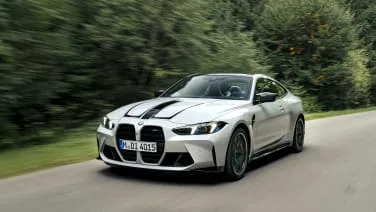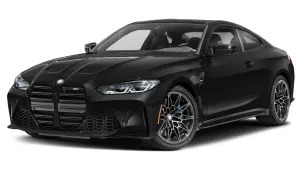Base 2dr Rear-Wheel Drive Coupe
2021 BMW M4

Industry
Despite all the criticism of steering feel and attacks on watered-down driving dynamics directed toward BMW these days, the company still has what it takes to make an enthusiast’s sports car. For evidence, look no further than the 2021 BMW M4. Forget the hyperbolic reaction to its twin nostrils and goofy hype videos. Just drive the new M4, and you’ll quickly tune out all of the internet keyboard warriors preaching that BMW has lost its way. If this car is what losing your way feels like, then count us in. The M3 and M4 (M4 again standing in for the M3 coupe designation) are historically inconsistent buggers. Over the generations, BMW went from a four-cylinder, to an inline-six, up to a V8 and then to a boosted inline-six more recently. We’re still in the Boost Age, so BMW kept the story simple this time with another twin-turbo inline-six. Where you’ll find the revolutionary change is in the arrival of the xDrive model. Yes, BMW for the first time is making all-wheel drive on option for both the M3 and M4 (and standard on the convertible), but that’s a story for another day. There are two versions of the new inline-six (codenamed S58), one for Competition models and one for the standard M3/M4. We drove the standard version with the six-speed manual. The two variants of the engine are different enough from a spec sheet perspective that we’ll hold off on drawing any conclusions on the Competition. How different? Only 30 horsepower separates them, but the real kicker — literally, it will offer more kick — is the Competition’s 73 lb-ft of additional torque. In whole numbers, the base engine makes 473 horses and 406 lb-ft of torque, while the Competition models crank out 503 horsepower and 479 pound-feet. That extra twist for the Competition is sent exclusively through an eight-speed torque converter transmission, not the dual-clutch automatic from the previous generation. The base engine’s manual gearbox saves 50 pounds, slightly improves the front-to-rear weight distribution, and is exclusively paired with rear-wheel-drive. It’s also a rare sight in luxury sports cars in 2021. You can’t spec the Mercedes-AMG C 63, Audi RS 5 or Alfa Romeo Giulia Quadrifoglio with three pedals, making BMW’s continued commitment to the stick shift all the more laudable. Neither the engine nor transmissions are what make the new M4 a superlative sports coupe, though. The wizardry in the chassis and suspension is what ultimately separates an M car from the standard models, and BMW nailed it this time. The litany of changes for the M model are enough to form an extra-run-on sentence, so here’s an abbreviated list: new aluminum wishbones, aluminum torque arm, forged swivel bearing, lightweight wheel bearings, lowered roll center and added crossbar stiffening to the front and rear subframe. Pop the hood, and you’ll find braces everywhere. The front track is 1.5 inches wider than before. The list goes on. What’s important to note here is that all of these changes make …
Full Review
Despite all the criticism of steering feel and attacks on watered-down driving dynamics directed toward BMW these days, the company still has what it takes to make an enthusiast’s sports car. For evidence, look no further than the 2021 BMW M4. Forget the hyperbolic reaction to its twin nostrils and goofy hype videos. Just drive the new M4, and you’ll quickly tune out all of the internet keyboard warriors preaching that BMW has lost its way. If this car is what losing your way feels like, then count us in. The M3 and M4 (M4 again standing in for the M3 coupe designation) are historically inconsistent buggers. Over the generations, BMW went from a four-cylinder, to an inline-six, up to a V8 and then to a boosted inline-six more recently. We’re still in the Boost Age, so BMW kept the story simple this time with another twin-turbo inline-six. Where you’ll find the revolutionary change is in the arrival of the xDrive model. Yes, BMW for the first time is making all-wheel drive on option for both the M3 and M4 (and standard on the convertible), but that’s a story for another day. There are two versions of the new inline-six (codenamed S58), one for Competition models and one for the standard M3/M4. We drove the standard version with the six-speed manual. The two variants of the engine are different enough from a spec sheet perspective that we’ll hold off on drawing any conclusions on the Competition. How different? Only 30 horsepower separates them, but the real kicker — literally, it will offer more kick — is the Competition’s 73 lb-ft of additional torque. In whole numbers, the base engine makes 473 horses and 406 lb-ft of torque, while the Competition models crank out 503 horsepower and 479 pound-feet. That extra twist for the Competition is sent exclusively through an eight-speed torque converter transmission, not the dual-clutch automatic from the previous generation. The base engine’s manual gearbox saves 50 pounds, slightly improves the front-to-rear weight distribution, and is exclusively paired with rear-wheel-drive. It’s also a rare sight in luxury sports cars in 2021. You can’t spec the Mercedes-AMG C 63, Audi RS 5 or Alfa Romeo Giulia Quadrifoglio with three pedals, making BMW’s continued commitment to the stick shift all the more laudable. Neither the engine nor transmissions are what make the new M4 a superlative sports coupe, though. The wizardry in the chassis and suspension is what ultimately separates an M car from the standard models, and BMW nailed it this time. The litany of changes for the M model are enough to form an extra-run-on sentence, so here’s an abbreviated list: new aluminum wishbones, aluminum torque arm, forged swivel bearing, lightweight wheel bearings, lowered roll center and added crossbar stiffening to the front and rear subframe. Pop the hood, and you’ll find braces everywhere. The front track is 1.5 inches wider than before. The list goes on. What’s important to note here is that all of these changes make …
Hide Full Review
Hide Full Review
Retail Price
$71,800
MSRP / Window Sticker Price
| Engine | 3.0L I-6 |
| MPG | 16 City / 23 Hwy |
| Seating | 4 Passengers |
| Transmission | 6-spd man w/OD |
| Power | 473 @ 6250 rpm |
| Drivetrain | rear-wheel |
Smart Buy Program is powered by 





